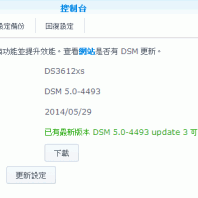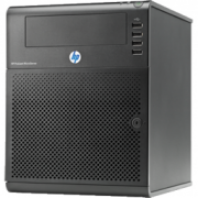雖然 Synolocker threat 唔影響 DSM 5.0, 以防萬一都係upgrade 左隱陣d 臺灣出現NAS勒索軟體災情,群暉證實舊版DSM漏洞釀災 Synology Advise Users of SynoLocker Ransomware Step 1: download download Nano-Boot 5.0.3.1 (DSM 5.0-4493) from http://www.xpenology.nl/boot-images/#IMG download DSM 5.0-4493 from official website http://www.synology.com/en-us/support/download/DS3612xs#download_tabs_dsm (direct link) download DSM 5.0-4493 update 3 from http://hkdl.synology.com/download/criticalupdate/update_pack/4493-3/synology_bromolow_3612xs.pat 其他 mirror sites: ukdl.synology | usdl.synology.com Step 2: write image to USB 打開 Win32DiskImager, select downloaded file: NB_x64_5031_DSM_50-4493_Xpenology_nl.img and write to USB drive Step 3: installation 關機, 插 USB再開機, boot up 1st GRUB menu: Nanoboot DSM 5.0-4493 Install/Upgrade 2nd GRUB menu: Nanoboot DSM 5.0-4493 (install/downgrade) 要等好一會才完成. 打開 Synology Assistant > search, 會顯示 migrateable, right click, install then select DSM_DS3612xs_4493.pat set up admin password, next … (可以行開沖返柸野飲, 都幾耐才完成安裝過程) Step 4: verify login diskstation, 控制台 > 更新 & 還原, 安裝版本: 5.0-4493 (as feature image) Step 5: upgrade to update-3 ssh root@diskstation
|
1 2 |
sed 's/flashupdateDeb/flashupdateDeb1/' /autoupd@te.info > /autoupd@te.info1 mv /autoupd@te.info1 /autoupd@te.info |
去返 UI, 更新. 會重新啟動(都係要等一陣), done! Side Notes: 3rd party packages: Package Center > Settings > Package Sources Name: synocommunity packages Location: http://packages.synocommunity.com
|
1 2 |
diskstation> cat /usr/syno/etc/packages/feeds [{"feed":"http://packages.synocommunity.com/","name":"SynoCommunity"}] |
updated on 2014-08-10: ignore & don’t use ipkg. it’s gone after upgrade and packages too old. I used Debian-Chroot from custom package provider instead DSM: Package Centre > Settings > Package Sources Name: SynoCommunity Location: https://synocommunity.com/packages ————————————– I am using HP N36L (AMD CPU), here just a record of my installation process. First things first, readings: http://forum.synology.com/wiki/index.php/Overview_on_modifying_the_Synology_Server,_bootstrap,_ipkg_etc#How_to_install_ipkg download bootstrap scripts for installation: http://ipkg.nslu2-linux.org/feeds/optware/syno-i686/cross/unstable/syno-i686-bootstrap_1.2-7_i686.xsh since I use USB as boot disk, my temp directory is on volume2 instead.
|
1 2 3 4 5 |
scp syno-i686-bootstrap_1.2-7_i686.xsh root@DSM:/volume2/@tmp/ ssh root@DSM cd /volume2/@tmp chmod +x syno-i686-bootstrap_1.2-7_i686.xsh sh syno-i686-bootstrap_1.2-7_i686.xsh |
Reboot DSM, @optware link created, path was set, to check:
|
1 2 3 4 5 |
# to check echo $PATH # insert to /root/.profile if missed PATH=$PATH:/opt/bin:/opt/sbin # Optware |
relogin ssh afterwards.
|
1 2 |
ipkg update ipkg install bash less vim |
|
1 2 3 4 5 6 7 8 9 10 |
# create new directory and cd in single command function mkdircd () { mkdir -p "$@" && eval cd "\"\$$#\""; } # ssh to remote host and go to directory function sshcd () { ssh username@"$@" -t "cd /path/dir1/dir2/ ; \$SHELL -l"; } ALL_HOSTS="hostname1 hostname2 hostname3" for AHOST in $ALL_HOSTS do alias ssh2"$AHOST"="sshcd $AHOST " done |
create/insert to .bashrc
|
1 2 3 |
if [ -f ~/.bash_aliases ]; then . ~/.bash_aliases fi |
Then $ source ~/.bash_aliases , $ ssh2hostname1 should go there directly if ssh without password configured.





